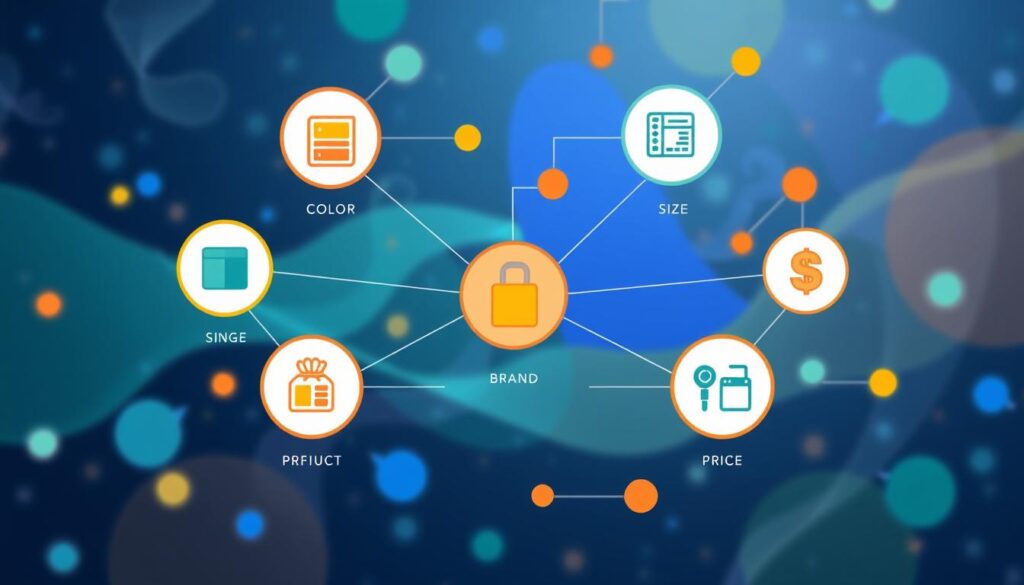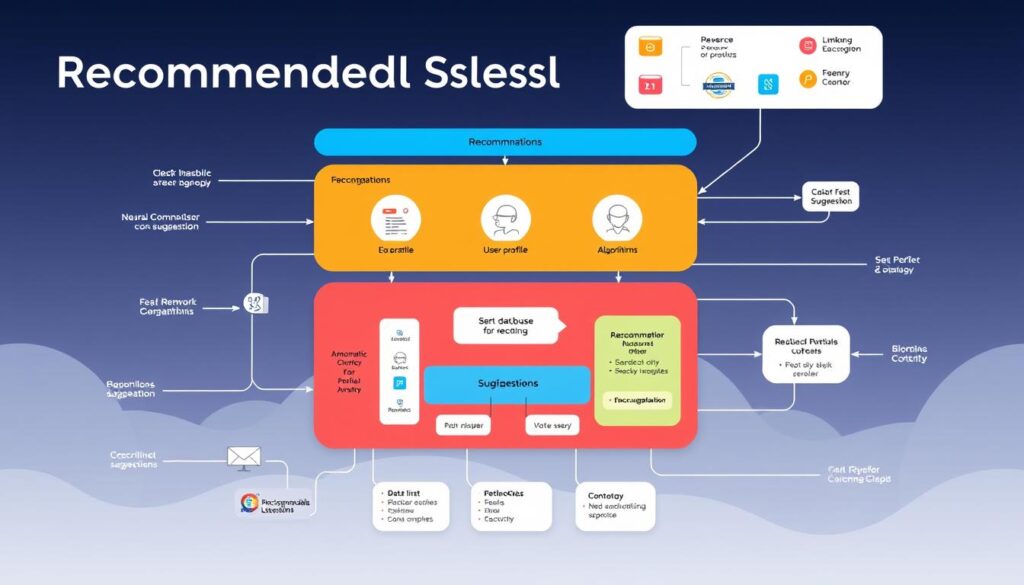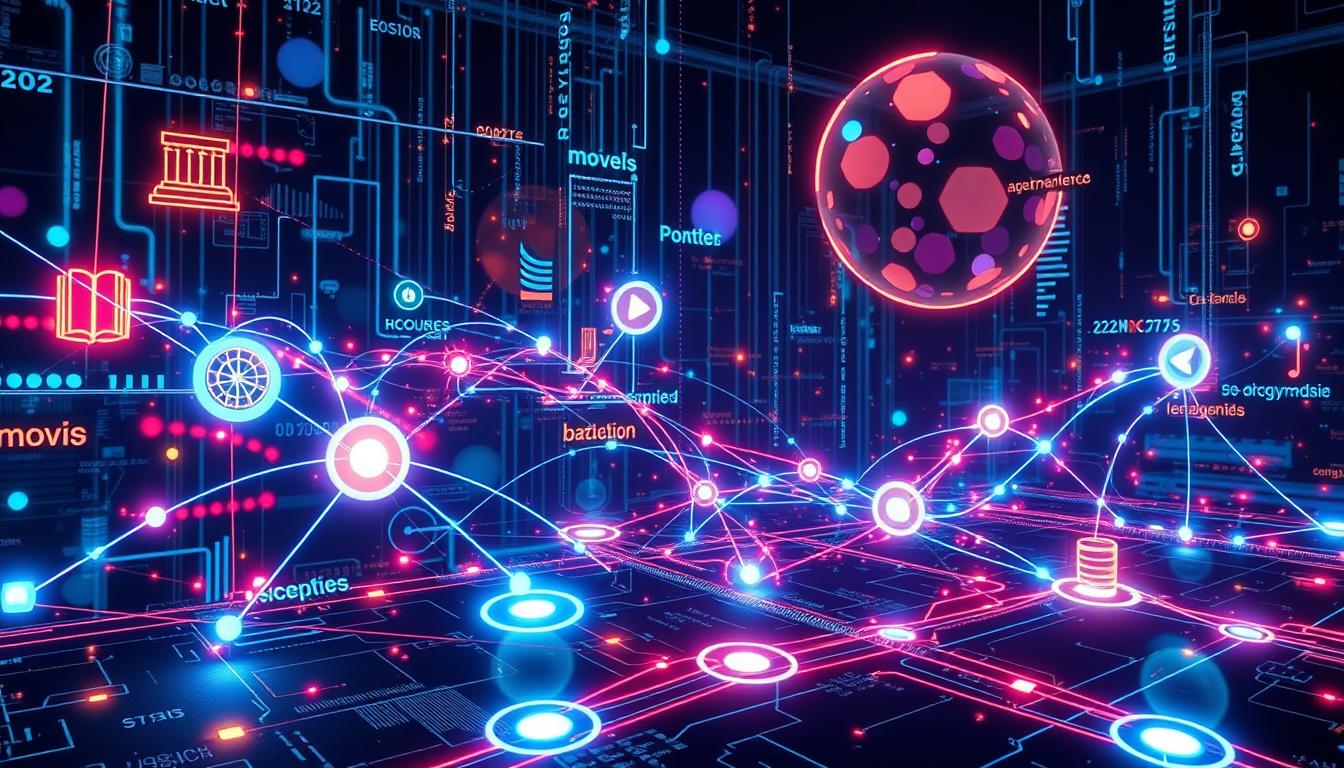“As an Amazon Associate I earn from qualifying purchases.” .
Have you ever wondered how Netflix knows exactly what show you’d love to watch next? Or why Amazon’s product suggestions always seem perfect? Welcome to the world of recommendation systems. Here, personalization algorithms and machine learning work together to give you a tailored online experience.
I remember the first time I saw the power of these systems. I was browsing an online bookstore, feeling lost among the endless choices. Then, a book caught my eye – it was exactly what I wanted, as if the website knew me. That moment made me curious about recommendation systems and how they change our online interactions.
Today, these smart suggestions are all around us, changing how we shop, watch, listen, and learn. They’re not just helpful; they’re changing businesses and user experiences everywhere. Did you know that recommendation systems make up about 35% of Amazon’s sales? Or that Netflix saves $1 billion a year thanks to its personalized content suggestions?
But it’s not just about making money. These systems are making our lives easier, helping us find new favorites, and even improving healthcare through personalized treatment. As we explore this guide, we’ll learn about the magic behind these intelligent algorithms and how they’re shaping our digital world.
Key Takeaways
- Recommendation systems drive 35% of Amazon’s sales
- Netflix saves $1 billion yearly with personalized suggestions
- Social media platforms use these systems to boost engagement
- Healthcare is adopting personalized recommendations for better patient care
- Content-based filtering and collaborative filtering are key algorithms
- Matrix factorization models enhance recommendation accuracy
- Generative AI is revolutionizing recommendation systems
What are Recommendation Systems?
Recommendation systems are smart tools that suggest items you might like. They use User Profiling and Data Mining to do this. These systems analyze your past choices to make personalized recommendations.
Definition and Overview
Recommendation systems are filters that guess what you might enjoy. They use complex algorithms to process lots of data. This helps users find new content, products, or services.
Historical Context
The start of recommendation systems was simple. They suggested items based on popularity. Now, they use advanced Data Mining techniques. Early systems used basic methods, while today’s use machine learning and AI.
Importance in Modern Applications
In today’s digital world, these systems are key. They make user experiences better, increase engagement, and help businesses grow. Here are some important stats:
| Aspect | Impact |
|---|---|
| Market Growth | Expected to reach $54 billion by 2030 |
| Annual Growth Rate | 37% compound annual growth rate |
| Application Areas | E-commerce, Streaming Services, IT Infrastructure |
| Benefits | Improved customer experience, increased conversions, higher revenue per order |
These systems do more than suggest products. They help with cross-selling, detect IT problems, and build loyalty. As User Profiling gets better, these systems will keep changing our digital lives.
How Recommendation Systems Work
Recommendation systems are powerful tools that analyze user data to provide personalized suggestions. They use sophisticated algorithms to process information and generate relevant recommendations.
Data Collection Techniques
These systems gather data through explicit and implicit feedback. Explicit feedback includes ratings and reviews. Implicit feedback involves user actions like clicks and viewing time.
For example, the MovieLens 100k dataset contains 100,000 ratings from 943 users on 1,682 movies. This dataset provides a rich source of explicit feedback for analysis.
Algorithms Behind Recommendations
Several algorithms power recommendation systems. Collaborative Filtering analyzes user behavior patterns to make predictions. Content-Based Filtering focuses on item features to suggest similar products.
Matrix Factorization is a technique that decomposes user-item interaction matrices. It uncovers latent factors.
Types of Recommendation Systems
Recommendation systems come in various forms:
- User-based systems compare similar users’ preferences
- Item-based systems recommend products with similar attributes
- Hybrid systems combine multiple approaches for enhanced accuracy
| System Type | Key Feature | Example Application |
|---|---|---|
| Collaborative Filtering | User behavior analysis | Netflix movie suggestions |
| Content-Based Filtering | Item attribute matching | Spotify playlist creation |
| Matrix Factorization | Latent factor discovery | Amazon product recommendations |
Evaluating recommendation systems often involves metrics like Root Mean Squared Error (RMSE) and Mean Absolute Error (MAE). These measures help assess the accuracy of predictions and guide improvements in system performance.
Types of Recommendation Systems
There are many types of recommendation systems, each designed for different needs and data types. They use Similarity Metrics and User-Item Interactions to suggest personalized items.
Content-Based Filtering
Content-based filtering suggests items based on what a user likes. It looks at item attributes and user profiles to find good matches. This method works well when there’s not much user data but lots of item details.
Collaborative Filtering
Collaborative filtering uses User-Item Interactions to predict what a user might like. It finds users with similar tastes and recommends items they’ve enjoyed. For instance, Amazon credits 35% of its sales to this method. The cosine similarity, ranging from -1 to 1, helps find these similarities.
Hybrid Systems
Hybrid systems mix different methods to overcome their own limits. They use Personalization Algorithms that combine content-based and collaborative filtering. Spotify’s “Discover Weekly” playlist is a great example. It uses collaborative filtering, natural language processing, and audio analysis for personalized recommendations.
| System Type | Key Feature | Example |
|---|---|---|
| Content-Based | Item attributes | News article suggestions |
| Collaborative | User similarities | Amazon product recommendations |
| Hybrid | Combined approaches | Spotify’s Discover Weekly |
Each recommendation system has its own strengths. They are chosen based on the data available and the specific needs of the application.
Key Components of Recommendation Engines
Recommendation engines are key tools for personalized experiences. They use three main parts: user profiles, item databases, and feedback. These help give users the right suggestions.
User Profiles
User profiles are the heart of recommendation engines. They hold info on what users like and do, thanks to Data Mining. This info helps understand what each person enjoys and does.
Item Databases
Item databases have all the details on products or content. They list things like categories, brands, and prices. This info helps match users with items they’ll like.

Feedback Mechanisms
Feedback is vital for better recommendations. It tracks how users interact, like clicks or ratings. This feedback helps the system get better at suggesting things.
In retail, these parts work together well. For example, 35% of Amazon’s sales in 2021 came from recommendations. Using user data and feedback, stores can increase sales and keep customers happy.
Applications of Recommendation Systems
Recommendation systems are key in many industries, changing how we interact with digital content. They use Personalized Marketing to help us find what we like and keep us engaged. This is true for many platforms.
E-commerce Platforms
Online stores use these systems to suggest products based on what we’ve looked at and bought. For example, Amazon’s recommendations are a big part of their success. The XCM team in Seattle is working on new marketing ideas to boost sales even more.
Streaming Services
Netflix uses smart algorithms to suggest movies and TV shows. These suggestions help keep viewers coming back for more. The latest update from AMD, ZenDNN v5.0, makes these systems even better.
Social Media Networks
Social media sites use recommendation systems to suggest friends, posts, and ads. They look at how we act to give us a more personal experience. This makes us spend more time on these sites.
| Industry | Application | Impact |
|---|---|---|
| E-commerce | Product suggestions | Increased sales, improved user experience |
| Streaming | Content recommendations | Higher user retention, personalized viewing |
| Social Media | Friend and content suggestions | Enhanced engagement, targeted advertising |
Google AI’s RecSim NG and RecList for testing show the field is always evolving. These updates help make our online experiences more personal and fun. They push the limits of Personalized Marketing and Content Discovery.
Benefits of Using Recommendation Systems
Recommendation systems are now key in digital platforms. They offer big wins for users and businesses. These systems use personalization to make experiences better and help businesses grow.
Enhanced User Experience
Personalization is vital for better user satisfaction. Recommendation systems look at what users like and suggest content. This makes finding what you want easier and less overwhelming.
Increased Sales and Engagement
These systems really boost sales and keep users coming back. Amazon says 35% of its sales come from recommendations. Netflix says 80% of what people watch comes from its suggestions. This means users are more likely to buy or watch what’s recommended.
Improved Customer Satisfaction
Recommendation systems help users find new things they like. This makes customers happier and keeps them coming back. Spotify’s “Discover Weekly” playlists are a great example of how good recommendations can make users happy.
| Platform | Impact of Recommendations |
|---|---|
| Amazon | 35% of purchases |
| Netflix | 80% of watched content |
| Rappi | 102% increase in click-through rates |
These benefits show why businesses are putting money into recommendation systems. They help grow and make user experiences better.
Challenges in Recommendation Systems
Recommendation systems face big hurdles in User Data Protection, Ethical AI, and System Performance. As these systems get more complex, solving these issues is key to keeping user trust and effectiveness.
Data Privacy Concerns
The big collection of personal data worries many about User Data Protection. To work well, these systems need lots of data. But, this often goes against privacy laws and what users want. Companies must find a balance between making things personal and protecting data to gain customer trust and follow the law.
Learn more about balancing personalizationand data protection
Algorithmic Bias
Ethical AI is a big worry in these systems. Algorithmic bias can mean unfair or limited suggestions for some users. This problem comes from biased training data or flawed design. To fix it, developers need to use diverse data and check for bias often.
Scalability Issues
As more users and items are added, System Performance becomes a big challenge. These systems must handle huge amounts of data and give quick suggestions. They need fast algorithms and strong systems to do this. Cloud computing and distributed systems help, but setting them up is hard and expensive.
“Large Language Models are transforming recommendation systems by addressing challenges like domain-specific limitations and cold-start issues.”
To overcome these challenges, companies are exploring new tech. Large Language Models (LLMs) like GPT-4 and LLaMA are promising. They improve feature engineering and create personalized content. These models are great at zero-shot learning, making recommendations even with little data.
Building a Recommendation System
Creating a recommendation system needs careful planning and execution. We will look at the steps, tools, and best practices for making an effective system.
Steps to Develop a System
First, define clear goals for your system. Collecting and preprocessing data are key steps. The system architecture must handle data efficiently and deploy models well.
Then, pick the right machine learning models. Options include collaborative filtering and content-based methods. Use the chosen algorithms and keep improving the system based on performance.
Tools and Technologies Required
Python is the top choice for building recommendation systems. Use Python 3.12.x for the best compatibility. Essential libraries include:
- Scikit-learn for machine learning algorithms
- TensorFlow for deep learning models
- Sentence-Transformers for generating embeddings
- NumPy for numerical computations
- Gradio for creating web interfaces

Best Practices for Implementation
Make sure data is clean through thorough preprocessing. Pick algorithms that fit your needs. Use A/B testing for ongoing improvement. Focus on these key metrics:
| Metric | Value | Purpose |
|---|---|---|
| Mean Average Precision | Varies | Evaluate model accuracy |
| Mean Squared Error | Calculated post-training | Measure prediction errors |
| Similarity Threshold | 0.5 | Filter recommendations |
| Number of Recommendations | Top 5 | Limit output for users |
By following these steps and using the right tools, you can build a strong recommendation system. It will improve user experience and increase engagement.
Evaluating Recommendation Systems
Measuring the success of recommendation systems is key for businesses. They aim to improve user experience and increase sales. Performance Metrics are essential for this.
Metrics for Success
Important metrics include precision, recall, and Mean Average Precision (MAP). These show how accurate and relevant the suggestions are. User Satisfaction is also vital, often checked through surveys or feedback.
| Metric | Description | Importance |
|---|---|---|
| Precision | Ratio of relevant recommendations to total recommendations | High |
| Recall | Ratio of relevant recommendations to total relevant items | Medium |
| MAP | Average precision across multiple queries | High |
A/B Testing Methods
A/B testing is vital for comparing different algorithms or system versions. It shows two variants to users and sees which one does better. This method helps refine recommendations and boost Conversion Rates.
User Feedback Analysis
Looking at user feedback gives insights into real-world performance. It shows where to improve and checks if the system meets user preferences. Keeping the system effective and adapting to user needs is essential.
“75% of what people watch on Netflix is driven by their recommendation algorithms.”
This fact shows how important well-evaluated recommendation systems are. They greatly impact user engagement and satisfaction.
Future Trends in Recommendation Systems
Recommendation systems are changing fast, with new ideas coming up. Walmart Global Tech in Sunnyvale, CA, is at the forefront. They’re working on blending online and in-store shopping to guess what customers want better.
AI and Machine Learning Integration
Deep Learning is changing how we get recommendations. New models like Recurrent Neural Networks and Convolutional Neural Networks are being used. They can handle lots of data, making suggestions that really fit what you like.
Personalization Advancements
Context-Aware Recommendations are the next step in making things personal. By mixing online and in-store data, systems get a full picture of what you like. This way, they can suggest things based on where you are, when you are there, and what you’ve bought before.
Ethical Considerations
As these systems get smarter, we’re thinking more about ethics. Explainable AI is key to building trust. It makes AI choices clear, helping to fix worries about privacy and fairness. Also, linking these systems to goals like reducing poverty shows how important ethics in AI is.
| Trend | Impact |
|---|---|
| Hybrid Data Pipelines | Enhanced prediction of customer behavior |
| Sequential Modeling | Improved long-term user engagement |
| Ethical AI | Increased trust and transparency |
Case Studies of Successful Recommendation Systems
Recommendation systems have changed how businesses talk to users. Let’s look at some great examples. They show how personalized marketing and content curation boost user engagement.
Netflix and Content Suggestions
Netflix’s system is a big deal in streaming. It makes up 80% of what people watch. It looks at what you’ve watched and likes to suggest more, keeping you watching.
Amazon’s Product Recommendations
Amazon’s system is a big hit in personalized marketing. It helps make about 35% of Amazon’s sales. It looks at what you’ve bought and browsed, then suggests more, helping sales and keeping users engaged.
Spotify’s Music Discovery
Spotify’s “Discover Weekly” playlist is a hit in music curation. Every week, it gives you 30 songs it thinks you’ll like. It has over 100 million users, making music discovery and engagement on Spotify better.
| Platform | Key Feature | Impact |
|---|---|---|
| Netflix | Content Suggestions | 80% of watched content |
| Amazon | Product Recommendations | 35% of sales |
| Spotify | Discover Weekly | 100M+ users |
These examples show how good recommendation systems can really help. They boost user engagement, drive sales, and make users happier.
Resources for Learning More about Recommendation Systems
The field of recommendation systems is growing fast. It offers many chances for learning in data science and machine learning. To keep up, you can check out different learning platforms and industry insights.
Online Courses
Top educational sites have detailed courses on recommendation systems. Coursera and edX have programs that cover the basics and more. These courses include projects, so you can use what you learn in real situations.
Books and Articles
If you like learning at your own pace, there are great books. “Recommender Systems: The Textbook” by Charu C. Aggarwal is a detailed guide. Also, look at recent papers from RecSys 2024 for the latest trends.
Industry Forums and Communities
Places like Stack Overflow and GitHub have active communities. Here, experts share their knowledge and discuss the latest in the field. The ACM RecSys Conference 2025 in Prague and the RecSys Summer School 2025 in Vienna are great for networking. They let you meet experts and learn about new developments.
FAQ
What are recommendation systems?
How do recommendation systems work?
What are the main types of recommendation systems?
What are the key components of recommendation engines?
What are the benefits of using recommendation systems?
What challenges do recommendation systems face?
How are recommendation systems evaluated?
What are some future trends in recommendation systems?
Can you provide examples of successful recommendation systems?
Where can I learn more about recommendation systems?
“As an Amazon Associate I earn from qualifying purchases.” .



